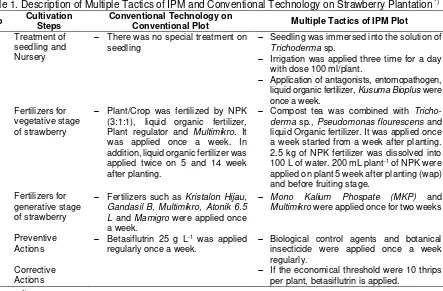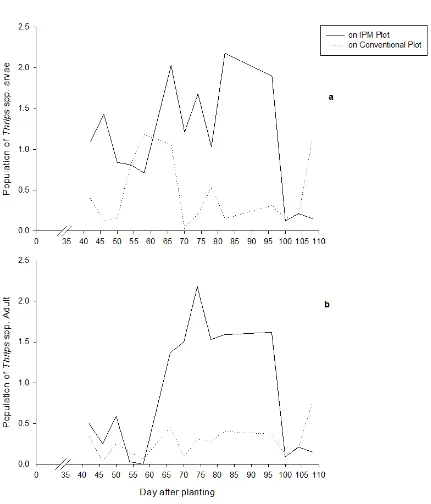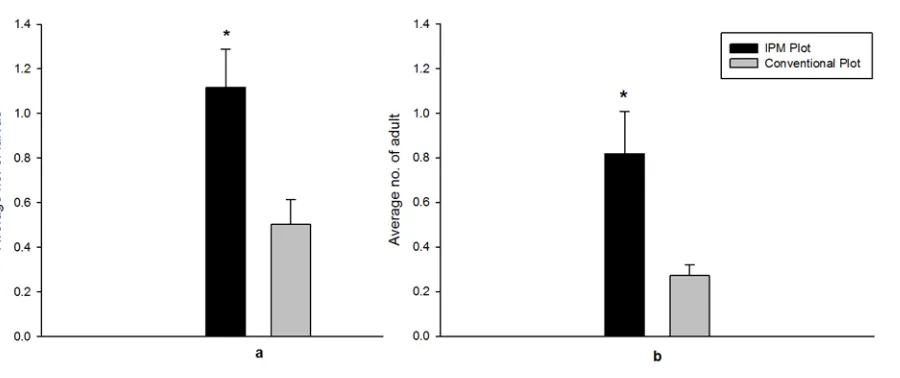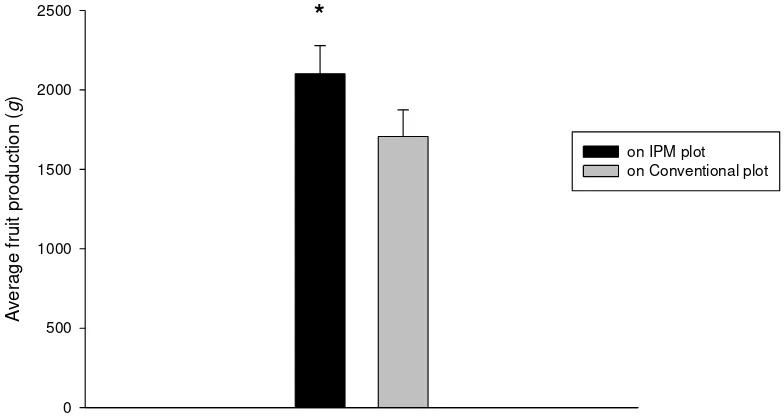MULTIPLE TACTICS OF INTEGRATED PEST MANAGEMENT FOR THRIPS
ON STRAWBERRY PLANTATION
Gatot Mudjiono*), Yahya Prasman and Aminudin Afandhi
Plant Pest and Disease Department, Faculty of Agriculture, University of Brawijaya Jl. Veteran Malang 65145 East Java Indonesia
*) Corresponding author Email: [email protected]
Received: February 5, 2015/ Accepted: May 12, 2015
ABSTRACT
In management of thrips on strawberry, farmers usually use synthetic insecticides. Synthetic insecticide is not effective to control thrips and produce residual effect on crops. Insecticidal residue is dangerous for human, natural enemies and environment widely. Therefore, it is necessary to find an alternative thrips pest control on strawberries, through integrated pest manage-ment (IPM) implemanage-mentation. Research was aimed to determine the effect of IPM technology for Thrips sp. on strawberry plantation. Research was conducted on strawberry plantation by comparing IPM and conventional plots, in Kusuma Agrowisata Batu from April to July 2009. Variables were used such as the number of larvae, adult population and damage intensity caused by Thrips sp., and fruit production. Data was analyzed by t-test on 5%. The results showed that the average larva and adult population of Thrips sp. on IPM plot were higher than conventional plot, 1.12 and 0.50 for larva and 0.87 and 0.27 for adults respectively. The damage intensity of strawberry crops on IPM plot was higher than conventional plot, 11.69 and 5.98% respectively. Based on average fruit production, IPM plot was higher than conventional plot, 48.32 g and 39.24 g respectively.
Keywords: damage intensity, fruit production, IPM, strawberry, Thrips sp.
INTRODUCTION
Strawberry is commonly planted on farm with altitude ca. 1,000-1,500 meters above sea level (masl) in Indonesia. Farmers in Sukabumi, Cianjur, Cipanas, Lembang, Bedugul and Malang regencies cultivate strawberry as their main crop.
Kusuma Agrowisata Company is one of the companies which cultivate strawberry on their farm in Malang. They cultivate strawberry on polybag and place on opened field.
There are at least 6,000 species of thrips in the world. A few of the main species of thrips were known to injure greenhouse crops (Greer and Diver, 2000). Most pests have been found in three genera, Frankliniella, Scirtothrips, and Thrips (Granadillo, 2014). Thrips is commonly a pest problem on strawberry plantation and they can cause ca. 30% damage (as a marketable product) and ca. 10% damage (not marketable product) (van Kruistum and den Belder, 2014). Thrips sp. is classified into Thysanoptera with brownish yellow and their body is less than 2 mm in length. They attack strawberry leaves and flowers (Little, 1963). Russeting around seeds from late green to ripe fruit and deformed fruit can be resulted by thrips attack (Ullio, 2009).
Because of the exceedingly low tolerances for damage, the management of thrips on crops has relied heavily on insecticides, which risk the development of insecticide resistance.There are synthetic insecticides used by farmers i.e.: pyrethroid, spinosad, abamectin, thiametoxam, methiocarb, and deltametrin (Granadillo, 2014). In addition, it produced residual effect on crops. Insecticidal residue is dangerous for human, natural enemies and environment widely. Therefore, it is necessary to find an alternative pest control Thrips sp. on strawberries, through integrated pest management (IPM) imple-mentation.
There are two approaches in IPM, namely technological and ecological based approaches. Ecological based pest management was adopted in Indonesia. All IPM components are evaluated based on their advantages and limitations then used and integrated in all steps of cultivation. It
Accredited SK No.: 81/DIKTI/Kep/2011
is named as preemptive action (Smith, 1978; Dufour, 2001).
Research was aimed to determine the effects of multiple tactics of IPM and conventional technology for thrips population on strawberry plantation. Fruit production was additional variable to investigate on two different conditions of plots, multiple tactics of IPM and conventional plots.
MATERIALS AND METHODS
Research was conducted on strawberry plantation, in Kusuma Agrowisata Batu from April to July 2009. There were two compared treatments i.e.: the multiple tactics of IPM and the conventional technology to control Thrips sp.on strawberry plantation.
Sweet Charley variety of strawberry, Kusuma Bioplus compost, soil, burned rice husk, compost tea, humic acid, bokashi, betasiflutrin 25 g L-1 of insecticide and chemical fertilizers (NPK, SP-36, MKP, and Multimikro) were used as materials. Beauveria bassiana, Lecanicilium sp., Tricoderma sp., Pseudomonas fluorescens,
Bacillus subtilis, Metarhizium sp., and Glio-cladium sp., and tobacco extract were also used as biological control agents and botanical insecticide was used as additional material in this research.
Strawberry was planted on polybag with 60 cm in height and 40 cm in diameter. Compost, soil and burned rice husk with a ratio 1:1:1 were used for plantation media. Compost was fermented from cow and sheep manure, and burned rice husk was used with a ratio 7.5:2.0:0.5 respectively. Each polybag was arranged on field with distance 30 cm between each other. Four strawberry seedlings were planted on each polybag with 15 cm in distance between each other.
There were one hundred polybags prepared for each plot such as IPM and conventional plots. Totally, there were 400 plants on one hundred polybags of IPM. The same populations of plants on one hundred polybags were also prepared for conventional plot. Differences of treatments in each cultivation step between IPM and conventional one were described in Table 1.
Table 1. Description of Multiple Tactics of IPM and Conventional Technology on Strawberry Plantation *)
No Cultivation Steps
Conventional Technology on
Conventional Plot Multiple Tactics of IPM Plot 1 Treatment of
seedling and Nursery
There was no special treatment on seedling
Seedling was immersed into the solution of
Trichoderma sp.
Irrigation was applied three time for a day with dose 100 ml/plant.
Application of antagonists, entomopathogen, liquid organic fertilizer, Kusuma Bioplus were once a week.
2 Fertilizers for vegetative stage of strawberry
Plant/Crop was fertilized by NPK (3:1:1), liquid organic fertilizer, Plant regulator and Multimikro. It was applied once a week. In addition, liquid organic fertilizer was applied twice on 5 and 14 week after planting.
Compost tea was combined with
Tricho-derma sp., Pseudomonas flourescens and
liquid Organic fertilizer. It was applied once a week started from a week after planting. 2.5 kg of NPK fertilizer was dissolved into 100 L of water. 200 mL plant-1 of NPK were applied on plant 5 week after planting (wap) and before fruiting stage.
3 Fertilizers for generative stage
Multimikro were applied once for two weeks
4 Preventive Actions
Betasiflutrin 25 g L-1 was applied regularly once a week.
Biological control agents and botanical insecticide were applied once a week regularly.
5 Corrective Actions
If the economical threshold were 10 thrips per plant, betasiflutrin is applied.
Variables were used such as the number of larvae, adult populations and damage intensity caused by Thrips sp., and fruit production. Absolute method was used to observe number of Thrips sp. larva and adult populations on whole leaves and flowers of each plant sample. Observation was started from 6 to 15 weeks after planting (wap). To calculate damage intensity of Thrips sp., formula as below was used
All data of each variable was analyzed by t-test on 5%. In addition, fruit production was harvested and calculated every two days.
RESULTS AND DISCUSSION
Population of Thrips sp. Larva and Adults
Based on Figure 1, at first observation (42 dap), there was Thrips sp. Larvae and adult on IPM and conventional plots in different level of population found. There were different tendency between both plots. On IPM plot, population of Thrips sp. larvae was from 46 to 58 dap, decreased slowly. Population of adult was also similar to the population of larvae. Larvae and adult population increased significantly from 62 dap to 90s dap. However, in the case of larvae there was fluctuation between 65 and 80s dap. The highest population of larvae and adult were at 82 and 74 dap respectively. At 100 dap, population of larvae and adult decreased significantly because of application of insecticide on plots. Application of insecticide on IPM plot was based on economic threshold which already reached at 10 population of Thrips sp. per crop.
On conventional plot, there was different condition on population of larvae and adult. Population of larvae increased between 50s and 60s dap, and it was not related to population of adult. At 70s dap, population of larvae and adult tended to be stable continuously at less than 0.5. Application of insecticide on conventional plot was the reasonable factor to control and keep population of larvae and adult at the lower level.
After 100s dap, population of larvae and adult increased significantly because there was no application of insecticide.
There was similar condition between Thrips sp. larvae and adult population (Figure 2). Populations of larvae and adult on IPM plot were significantly different compared to conventional plot. Population of larvae and adult on IPM plot were twice higher than on conventional plot.
At least, there are three reasons why the population of thrips was higher on IPM than conventional plots during increasing population period. Firstly, the ratio of natural enemies and thrips on IPM plot was not enough to control the population of thrips. As an example, one minute pirate bug is needed to suppress 180 thrips and at a ratio of about one predator to 40 thrips, thrips populations are controlled (Demirozer et al., 2012). Minute pirate bugs, such as Orius niger, O. insidiosus, O. pumilioare are potential candidates for biological control of thrips (Funderburk et al., 2009; Atakan, 2011). Secondly, there are no companion/refugia plantings on strawberry plantation. Companion/ refugia plants species offer habitat for important natural enemies of thrips (Funderburk et al., 2009; Demirozer et al., 2012). Finally, there are no application of suitable insecticides (Demirozer et al., 2012). Application of insecticides, such as spinosad (Reitz et al., 2003), spinetoram, pyridadyl, and essential oils are compatible to reduce population of thrips (Funderburk et al., 2009).
Damage Intensity caused by Thrips sp. on Strawberry Plantation
Based on Figure 3, there were fluctuation of damage intensity on IPM and conventional plots. Damage intensity on IPM plot fluctuated and ranged between 10 and 18% from 42 to 90s dap. In case of conventional plot, damage intensity fluctuated from 42 to 70s dap. There was the highest damage intensity at 55 dap, and then decreased slowly and stopped at 70 dap. Insecticide application regularly on conventional plot caused the population of Thrips sp. larvae and adult tended to be stable on the low level, and finally it related to the low level of damage intensity.
Damage intensity on IPM plot was higher than conventional plot becaused populations of Thrips sp.larvae and adult were higher from 42 to 100 dap. There was no application of insecticide at
those interval observation could be a reasonable factor to describe the high damage intensity on IPM plot.
Damage intensity of strawberry on IPM plot was higher than conventional plot. It was related to population of thrips. Population of both stages thrips contributed to the damage intensity of strawberry. However damage intensity on IPM plot was higher than conventional, and it can be tolerated because of economical threshold. Economical threshold of thrips on strawberry ca. 10 and 20 thrips per flower for winter and spring
respectively (Coll et al., 2007). Insecticide was applied on IPM plot, when population of thrips reached economical threshold. The suitable insecticide such as spinosad can reduce population of thrips significantly with few impact on natural enemies such as minute pirate bugs (Reitz et al., 2003; Coll et al., 2007; Funderburk et al., 2009).
Figure 2. Average of number of larvae (a) and adult (b) on both plots (* symbol described there was significantly differences between both plots based on paired t-test 5%)
Day after planting
0 35 40 45 50 55 60 65 70 75 80 85 90 95 100 105 110
Da
mage I
ntens
it
y
(%
)
0 2 4 6 8 10 12 14 16 18 20
on IPM plot on Conventional plot
Figure 4. Average damage intensity of Thrips sp. on both plots of strawberry plantation (*symbol described significant differences between both plots based on paired t-test 5%)
Figure 5. Average fruit production on both plots of strawberry plantation (*symbol described significant differences between both plots based on paired t-test 5%)
A
v
e
ra
ge
f
ru
it
p
ro
d
u
ct
io
n
(
g
)
0 500 1000 1500 2000 2500
Fruit Production of Strawberry Plantation
There was significant difference between IPM and conventional plots based on fruit production average (Figure 5) IPM and conventional plots produced 2,100 and 1,706 g of fruit respectively. Organic fertilizer and beneficial microorganisms were applied on IPM plot routinely and it should be one of the reasons of the high fruit production. Some biological pesticides and inputs could be another factor which supported pests and diseases control. In addition, synthetic insecticide were applied when the population of Thrips sp. reached 10 per each crop, and it should be an important strategy to prevent the reduction of fruit production (Coll et al., 2007).
Organic fertilizer and some biological pesticides and beneficial microorganisms could be responsible factors to keep strawberry plants on the good growth and development. There are some pests and diseases on strawberry such as anthracnose, grey mould, leaf spot, gnomonia fruit rot, Fusarium wilt, root weevil, bud weevil, white grubs, and nematodes (Ullio, 2004; Delbridge and Rogers, 2013). All complex of pests and diseases on strawberry could be reduced by multiple tactics of IPM plot.
CONCLUSION
Multiple tactics of IPM did not reduce population and damage of thripson strawberry plantation. It was shown that the average larva and adult population of thrips on IPM plot was higher than conventional plot, 1.12 and 0.50 for larva and 0.87 and 0.27 for adults respectively. The damage intensity of strawberry crops on IPM plot was higher than conventional plot, 11.69 and 5.98% respectively.
However multiple tactics of IPM could not be an effective way to reduce the population and damage of thrips, but it was usefull to increase quantity and quality of fruit production of strawberry. Average fruit production, IPM plot was higher than conventional plot, with 2,100 and 1,706 g respectively.
REFERENCES
Atakan, E. 2011. Population densities and distributions of the western flower Thrips (Thysanoptera: Thripidae) and its predatory bug, Orius niger (Hemiptera: Anthocoridae), in Strawberry. International Journal of Agriculture and Biology 13 (5): 638-644.
Coll, M., S. Shakya, I. Shouster, Y. Nenner and S. Steinberg. 2007. Decision-making tools for Frankliniella occidentalis management in strawberry: Consideration of target markets. Entomologia Experimentalis et Applicata 122 (1): 59–67. doi: 10.1111/j. 1570-7458.2006.00488.x
Delbridge, R. and D. Rogers. 2013. A guide to insect, mite and disease management in strawberries in Nova Scotia. Perennia. pp. 19.
Demirozer, O., K. Tyler-Julian, J. Funderburk, N. Leppla and S. Reitz. 2012. Frankliniella occidentalis (Pergande) integrated pest management programs for fruiting vegetables in Florida. Pest Manag. Sci. 68: 1537–1545. doi: 10.1002/ps. 3389 Dufour, R. 2001. Biointensive intergrated pest
management. Appropriate Technology Transfer for Rural Areas (ATTRA). https://attra.ncat.org/attra-pub/viewhtml. php?id=146. Accessed August 28, 2014. Funderburk, J., S. Reitz, P. Stansly, D. Schuster,
G. Nuessly and N. Leppla. 2009. Managing Thrips in pepper and eggplant 1. Managing. p. 1–10.
Granadillo, J. 2014. Integrated pest management of western flower thrips. Universiteit Leiden-Universiteit Utrecht. pp. 32. Greer, L. and S. Diver. 2000. Greenhouse IPM:
Sustainable thrips control. ATTRA. p. 1-18. https://attra.ncat.org/attra-pub/ viewhtml.php?id=50. Accessed August 28, 2014.
Natawigena, H. 1985. Pesticides and their use (in Indonesian). Armico. Bandung. pp. 71. Reitz, S. R., E.L. Yearby, J.E. Funderburk, J.
Stavisky, M.T. Momol and S.M. Olson. 2003. Integrated management tactics for Frankliniella Thrips (Thysanoptera : Thripidae) in field-grown pepper. J. Econ. Entomol. 96 (4): 1201-1214.
Smith, R.F. 1978. History and complexity of integrated pest management. In E.D. Smith and D. Pimentel (Eds.). Pest Control Strategies. Academic Press. New York. p. 41-53.
Ullio, L. 2004. Strawberry weed control guide. NSW Agriculture. The State of New South Wales. p. 1-8.
Ullio, L. 2009. Common insect pests of strawberries Primefacts. New South Wales. p. 1-4. http://www.dpi.nsw.gov. au/__data/assets/pdf_file/0017/306314/ Common-insect-pests-of-strawberries. pdf. Accessed August 28, 2014.



